

First National Pictures
Cast: Colleen Moore (Jeannine), Gary Cooper (Capt. Phillip Blythe), Burr McIntosh (General Blythe), George Cooper (mechanic's helper), Cleve Moore (Flight Commander), Kathryn McGuire (Lady Iris), Eugenie Besserer (Widow Bertholot), Emile Chautard (Mayor), Edward Dillon (Corporal "Smitty), The Unlucky One (Arthur Lake), The Enemy Ace (Edward Clayton)
In the French village of Nailly-Les-Bourens, a lilac farm
has been converted into a British airdrome. Jeannine and the Widow
Berthelot keep the 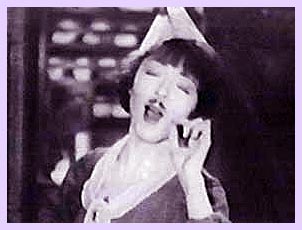 soldiers fed, and Jeannine also prays
to Saint Joan for the pilots' safe return from their daily missions.
When Captain Phillip Blythe arrives, Jeannine falls in love. Finally,
the time comes when the enemy is planning a big push for victory,
and all pilots are called to action and told to fight until they
are shot down or there's not a single enemy plane left. Although
the village must be evacuated, Jeannine returns so that she can
keep her promise to Phillip to be there when he returns. Jeannine
survives a bombing of the village, and Phillip does, indeed, return,
but, before he can land, the dreaded Red Ace shoots him down.
Jeannine stops a passing Red Cross truck, and Phillip is taken
to a hospital in Paris. She finally gets to Paris in hopes of
finding Phillip still alive.
soldiers fed, and Jeannine also prays
to Saint Joan for the pilots' safe return from their daily missions.
When Captain Phillip Blythe arrives, Jeannine falls in love. Finally,
the time comes when the enemy is planning a big push for victory,
and all pilots are called to action and told to fight until they
are shot down or there's not a single enemy plane left. Although
the village must be evacuated, Jeannine returns so that she can
keep her promise to Phillip to be there when he returns. Jeannine
survives a bombing of the village, and Phillip does, indeed, return,
but, before he can land, the dreaded Red Ace shoots him down.
Jeannine stops a passing Red Cross truck, and Phillip is taken
to a hospital in Paris. She finally gets to Paris in hopes of
finding Phillip still alive.
In 1924, Colleen Moore demanded and got the lead in the filming of Edna Ferber's "So Big." The film was only a moderate financial success but a major critical success for Moore. Nevertheless, the powers-that-be at First National were anxious for her to get back to the light comedies for which she was so well suited, and she did in such films as "Sally" (1925), "Ella Cinders" (1926), "Irene" (1926), "Twinkletoes" (1926) and "Orchids and Ermines" (1927), among others. In 1927, Moore and her husband-producer John McCormick were searching about for a story for a "prestige" picture, and McCormick bought Jane Cowl's stage hit "Lilac Time."
"Lilac Time" was in production before "Wings" (1927 starring Charles 'Buddy' Rogers, Richard Arlen and Clara Bow) was released, and it hit the screens almost a year after "Wings." Nevertheless, the inevitable comparisons were made. Mordaunt Hall in The New York Times (August 4, 1928), said, "Comparisons are odious, true, but 'Wings' with its more than 700 performances naturally springs to mind. 'Lilac Time' has a more complete story, but it is told in half-shades where 'Wings' is inclined to gamble all on boldness. The aviation portions are about the same in each of the pictures, although there are some excellent views of crashes in 'Lilac Time.' On the other hand, there is not quite so much airplane fighting."
Although Hall took a "middle-of-the-road" stance,
Welford Beaton in The Film Spectator (June 23, 1928) preferred
"Lilac Time." "By long odds a greater picture than
'Wings' is 'Lilac Time' . . . It is greater than the Paramount
picture because it is equally thrilling and, in addition, 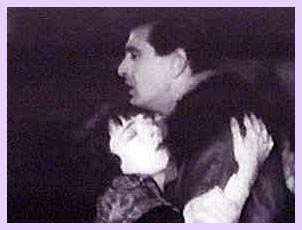 has
what 'Wings' lacks, a connected, coherent and dramatic story from
which it does not depart for as much as one foot of film. . .
As it lets nothing interfere with the telling, the story moves
swiftly along its logical course and holds our interest in it
as a story."
has
what 'Wings' lacks, a connected, coherent and dramatic story from
which it does not depart for as much as one foot of film. . .
As it lets nothing interfere with the telling, the story moves
swiftly along its logical course and holds our interest in it
as a story."
Actually, other than both stories utilizing World War I as their backgrounds, there is little comparison that can be made between the two movies. No one will argue that "Wings" is anything but a great picture, however, "Lilac Time" stands on its own merits. The mark of a good picture is if it accomplished what it set out to do and in good fashion -- "Lilac Time" did. It wasn't meant to be a war story, per se, but was intended to be a love story told from the perspective of a beautiful young French girl who happens to be caught up in the madness when the farm on which she lives is turned into a British airdrome. The war provides the setting, and, as such, impacts the lives of the two lovers - the French girl, Jeannine, and British pilot Capt. Phillip Blythe.
"Lilac Time" is a sensitive tale laced with beauty - the beauty of the lilac farm, the French countryside, the love of two young people, and the noble young men who lay their lives on the line to fight the evil of the world. Without the beauty, the horrors of war wouldn't be so horrible, and the anti-war theme is most definitely a mission of the film. Of course, any attempt to film a thing of beauty always opens itself to criticism. The New York Times said, "The trouble with the picture lies in its sentiment. War has been made a vehicle for love, and hatred has turned into a pathetic combination of all the virtues." The film hasn't escaped the sharp pen of modern writers, either. According to author Jack Spears (Hollywood: The Golden Era A.S. Barnes & Co., Inc., 1971), "'Lilac Time' tended to be maudlin and oversentimental, and lacked the sustained realism of war possessed by Vidor and Wellman films." Of course, Spears' reference here is to "The Big Parade" and "Wings."
The fact that the battle scenes don't begin until over an
hour into the 91-minute movie is a clear indication it wasn't
intended to be just another war picture. However, there are thrilling
dogfights and excellent photography of the battles against cloud-filled
backgrounds. In the minutes 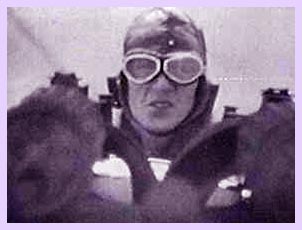 leading up to this portion of the film,
the stage is set well for the upcoming action drawing the viewer
in with nervous anticipation.
leading up to this portion of the film,
the stage is set well for the upcoming action drawing the viewer
in with nervous anticipation.
On the evening prior to the big battle, a large number of pilots have gathered at the farm for a "binge." In the midst of their revelry, a Brigadier General arrives and announces that the Germans have planned a "big push" to gain victory. He tells the pilots they must fight until every plane is shot down. "You mean, sir -- we are not to come back?" one particularly youthful-looking pilot nervously asks. "Not while a single enemy plane is in the air!" the General commands. On this note of hopelessness, the battle scenes begin.
Although Spears had criticized the film as being "maudlin," he did praise its picturization of the war. "Elaborately mounted and beautifully photographed (by Sid Hickox), it contained many spectacular aerial dogfights and battle scenes."
Moore noted in her autobiography (Silent Star, Doubleday & Co., Inc., 1968) that "Lilac Time" was budgeted at a million dollars during a time when $250,000 was sufficient for a "big" picture. She claimed that part of the reason was the expense of the air battles. "I found out soon enough when we started filming why 'Lilac Time' was going to cost a million dollars. It was a war story, and we used hundreds of extras, blew up a whole village, and destroyed seven airplanes -- our aerial dogfights done not with miniatures but with the real thing."
Much credit has been given to director George Fitzmaurice
for the success of "Lilac Time." According to The
New York Times reviewer, "The chief asset of 'Lilac Time'
seems to be the good direction on the part of George Fitzmaurice.
He has paid very careful attention to minute details, and if he
has occasionally added too many lilacs, he presumably could be
excused on the ground that it is that kind of a story." Speaking
of Fitzmaurice's directorial skills in general, Richard Koszarski
(Hollywood Directors 1914-1940, Oxford University Press,
1976), echoes much the same opinion. "As with later directors
like Hitchcock and Lubitsch, he knew beforehand everything that
he wanted to see on screen and expended the majority of his attention
on preparatory work far in advance of shooting. Indeed, here he
seems rather casual about his own efforts 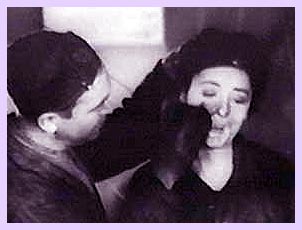 on the set, claiming
to 'never bother' about things like composition, even though his
films were widely known for their unaffected visual grace."
on the set, claiming
to 'never bother' about things like composition, even though his
films were widely known for their unaffected visual grace."
In spite of spectacular air battles and adept direction, "Lilac Time" couldn't have been the success it was without Colleen Moore. Much of the comedic Colleen with whom we are so familiar is there. For example, dressed in a mechanic's work clothes, she offers to help Corporal Smitty. He pretends to wipe something off her face, but uses a greasy rag to do so. The more he wipes, the dirtier her face becomes, and all the while, she turns her face upward willingly not realizing the practical joke. In another sequence, she is hiding in the cockpit of a plane, and when the propeller is spun to crank the engine, she accidentally releases the brake. The plane darts to and fro around the field with a whole troop of pilots and others chasing after it a la Keystone Cops.
Actually, the comedy is used realistically and judiciously, and, once the drama begins, we see a different Colleen Moore. Moore was one of the most expressive actresses of the silent era and effectively conveys apprehension as she waits for the planes to return from their daily mission, anger as she cries, "That's not war -- little boys shot down from kites in the sky," heartbreak as "the unlucky one" is taken away by the ambulance, sympathy as she gives a young pilot courage to go into battle, terror as she kisses and hugs her lover for the last time before he flies into almost certain death, and tear-filled surprise, then joy, when she realizes Blythe is still alive. And, although the romance in most of Moore's movies would be considered "light," she is very adept at passionate love scenes as her kisses in the tight clenches with co-star Cooper reveal.
According to author Jeanine Basinger (Silent Stars, Wesleyan University Press, 2000) who says she was named for Moore's character in "Lilace Time," " . . . every opportunity (is given) for her to dimple and smile and make comic faces . . . At the same time, however, she is also presented as a beautiful woman. She dresses in a lace cap and buries her face in huge bunches of lilacs. She prays, she begs, she weeps. She's photographed in lingering close-ups in which she is meltingly lovely. 'Lilac Time' is a full showcase of the Moore talent -- she's both comedienne and dramatic leading lady, both half child (or half doll) and emotional lover who responds to passionate kisses. With Moore, audiences got everything in one."
For anyone who doesn't believe Moore can do drama and do it most movingly, just take a look at the final minutes of this movie. We are given a close-up of Moore as she turns from the street to look up at the hospital and tell her dead (or so she thinks) lover that her love will never die. Then, as she speaks, there in the window is the weak Capt. Blythe, all wrapped up in bandages, barely able to call out to her. Moore's handling of this tender moment is emotionally wrenching and the impact reminds one of the final scene in Chaplin's "City Lights" (1931) when, by the touch of his hand, the formerly blind girl realizes it was this little, ragged tramp who paid for her eye operation. This is what makes silent film so great!
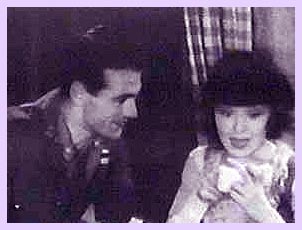
Gary Cooper is an asset to this movie, too. Certainly he went on to better and more demanding roles, but he rises to the occasion with this one giving a creditable performance in scenes such as the one in which he must tear himself from the distraught Jeannine as he goes into battle or when, weak and recovering from his injuries, he calls out to Jeannine from his hospital window although she can't hear him.
Of his performance, The New York Times said, "Gary Cooper, as the young man with whom Jeannine falls in love, is passable but not much more," however reviewer Beaton said in The Film Spectator, "Gary Cooper gives a splendid performance in 'Lilac Time.' He is more human and likable than I have seen him in most of his pictures."
Released well after Al Jolson's The Jazz Singer and on the brink of the sound era, Moore and McCormick thought it would be "a novelty" to have a synchronized music score to accompany the film. After it was finished, a print was sent to New York where a 100-piece orchestra recorded a score on film that would be synchronized with the film of the movie. The morning of the film's premiere at Cathay Circle Theatre in Beverly Hills, the new score was tested, and, according to Moore, the film on which the score was recorded broke three times. McCormick hired a 100-piece orchestra to be on hand at the theatre in case the film broke during the performance that evening, but she said the premiere "went off without a hitch."
The print reviwed here is from Critic's Choice video with an enjoyable organ music score compiled and played by Therese Meyer. In a couple of scenes the viewer is also treated to the sound of planes in the distance. The score also includes the film's theme song "Jeannine, I Dream of Lilac Time." The print is far from "sparkling" and tends to be slightly dark much of the time. Also, it appears that the titles are not from the original issue, although they are done well.
copyright 2002 by Tim Lussier, all rights reserved.